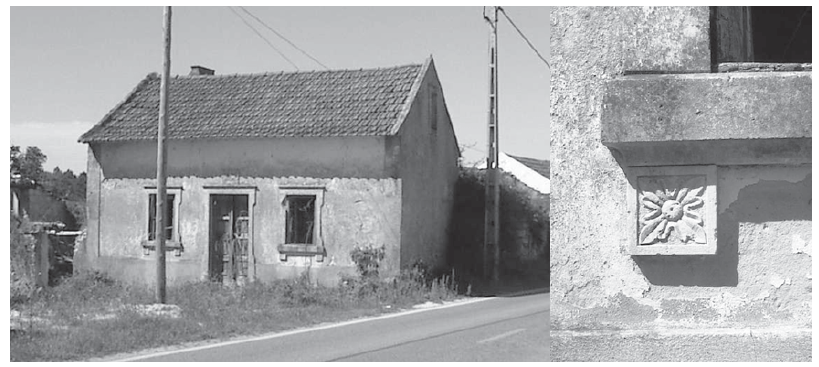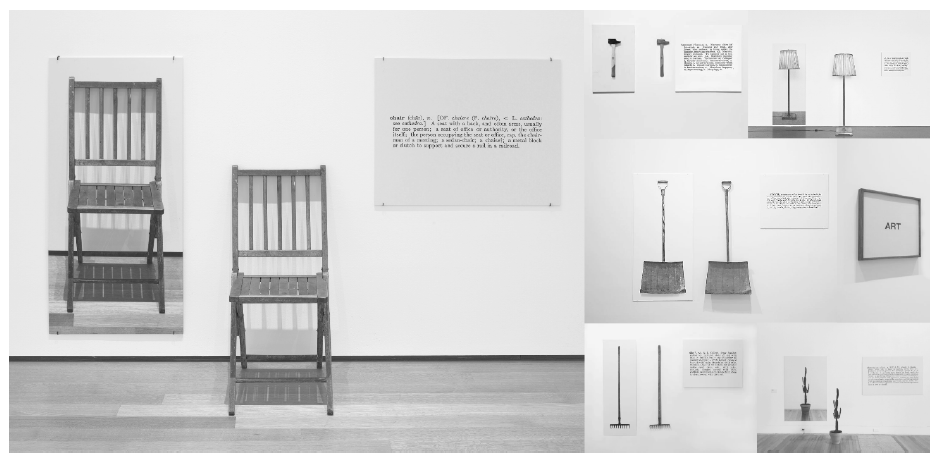1. Introduction
Based upon the premise of Joseph Kosuth’s work, this article will propose a triangular reasoning in which different situations will be approached, the common ground being the discussion artists do about their counterpart’s artwork.
The purpose is to show the use of this kind of approach as a source of knowledge or matter for thinking, which artists use to devise a cohesive theory within their practice, in Art, Architecture, Design or another subject.
In other words, more than a monologue, those who dwell in others’ artwork create a dialogue from the moment they draw answers from the exchange of experiences.
2. Problem
When analysing contemporary art, architecture, and design (which we can consider all Art in a broader sense) we are faced with the dispersion of ideas and theories which lack the identification of a common denominator among them for us to identify a movement or even a global coherence.
This may be caused by the historical proximity of such theories and practises which don’t allow us to have the necessary distance to identify a “shared belief”. Or, on the contrary, it may be that such a dispersion is the common denominator among contemporary thinking, in which case we won’t have time on our side to make an understanding of such theories and practices.
In both cases, this translates into difficulty in understanding the status quo, becoming harder and harder to evaluate our contemporaneity since to understand art is to comprehend each artist individually, through signs and logic that are not always clear to all (and are not communicated by those who create them).
So, what can we “trust” to sustain an opinion or logic about art and the world in general? In what can we “dwell” to support our reasoning to create our art pieces (visual, written, sung, built, etc.)?
3. Methodology & Status Quo
The presented paper is established upon the empirical experience of the author on the subject, not because it tries to sustain its reasoning without thorough research, but because it describes a process that was designed over an elongated period: he went through several experiences without an (apparent) link, but they ended fuelling reasoning within Architecture, Art or (and) Design, helping to devise a strategy for intervening in each of them. Or all of them.
Therefore, it is hard to retain a classical structure in which we can easily specify a methodology, where a question or doubt was put, related case studies related were collected and studied, and conclusions were drawn, supported by comprehensive literature: the following experiences, which we can consider as case-studies in the present paper’s context, weren’t “collected” or even remembered with a particular purpose, although they are now serving one.
As those experiences succeeded, they started to make sense as a whole, devising an approach to Architecture, Art or (and) Design, which the proposed paper tries to deepen, now supported by the necessary literature.
It must be said that such need - for a theoretical or practical approach to those disciplines - wasn’t consciously felt, although practice often raised questions that needed clarification for a project to continue its due course. Making sense of it all resulted in the presented analysis, as a conclusion (for now) of the path taken.
Still, we can identify a process in which, when artists discuss their counterpart’s artwork, as a source of knowledge, or food for thinking, they end up applying such knowledge in their artistic production, since it helps them devise their theories and methodologies.
At this point, we could consider the following paper as a linear path with three pitstops, but the fact is that discussing Joseph Kosuth’s “One and Three Chairs” - the last stop -leads us back to the moment when Eduardo Souto de Moura’s “Pousada de Santa Maria do Bouro” was debated - the first stop - therefore closing a triangle.
In other words, the first case study to be presented will sustain the second - a personal experience - sustaining the third and last case study (which could be considered this paper’s conclusion, if it wasn’t for its triangular route).
The above-mentioned comprehensive definition of art includes architecture, which is important to state, as the “triangle’s” first vortex is an architect and one of his projects. Although we are not going to resume our thinking about this discipline, this will be the initial “voice” starting the first dialogue, in which Contemporary Art, and, most noticeably, Conceptual Art, are the (apparent) culmination of a path started with an architect leaning upon another artist’s work, followed by an architect (the author) learning from other artist’s creation, concluding with a visual artist (also the author) discussing another artist’s work
4. The other as a crutch.
Eduardo Souto de Moura is an architect that has always been very keen on hiding the sensitivity that he so thoroughly applies in his artistic production. It’s undoubtedly with humour that he states that the handrail he designed for Metro do Porto, similar in every station, is produced as a continuous object cut to size for each one, like the “churros’ man” does (RTP, 2020).
Its design is easily recognizable as his own, but its Meaning, a fundamental condition for architecture to be art (Rannells, 1949), remains hidden under Souto de Moura’s good-natured character.
During a presentation of his “Pousada de Santa Maria do Bouro” project (built - and not rebuilt, as we will see - over the remains of an ancient monastery), he started his lecture by showing the ruins he encountered when he was commissioned for the project, but also with Joseph Beuys’ 1974 performance “I like America, and America likes me” (Coyote, n.d.). There’s no need for extensive descriptions of this performance, given its seminal character, which makes it well-known to almost any art lover. Let’s just recall that during its performance with a coyote, seen by Native-American culture as a symbol of transformation (Wolfe, 2019), Beuys wanted to establish a comparison with the transformation he wanted for the United States of America (Yeung, n.d.).
Souto de Moura wanted to tell us, through this analogy, that the ruin, as the basis for the forthcoming project, offered him the same resistance the coyote offered Joseph Beuys: during the performance, the animal altered his behaviour, from aggressive to calm (Wolfe, 2019), always showing potential for change. At the same time, Souto de Moura presented the process in which he “domesticated” the ruined building, always in a light and humorous fashion (he didn’t know if he was going to “use” roof tiles, he was “tired” of yellow and pink walls, etc.), interleaving his presentation with images of “I like America, and America likes me” and describing Beuys’ performance.
Although we should focus on the relation established between architecture and art, we couldn’t go on without exploring the turning point that determined his intervention in the ruin: preliminary excavations around the ruined monastery revealed its original appearance, which consisted of blood-red painted walls, and 1,2 meters long glazed dark green roof tiles. So, it was not yellow or pink he said he was tired of, nor the red clay roof tiles we were expecting: to rebuild the monastery according to its original appearance would be to recreate an image that would only cause us awkwardness and discomfort; to create the “expected” appearance, with lighter colours and red roof tiles, would be to create a lie. The alternative was to resort to the true memory anyone had of the monastery: the ruin, the result of a degradation process started in 1834, when it was abandoned after the extinction of the religious orders in Portugal (Sampaio, 2012).
Consequently, the architect stated that to remain faithful to the image we had of the monastery, instead of rebuilding the ruin, he would build a new building, using the ruin’s stones to design a hotel (Sampaio, 2012), always “interrupting” its narrative to present the development of Joseph Beuys' performance.
Therefore, the Pousada de Santa Maria do Bouro was the result of the Meaning the architect gave it, “finally” corresponding to Rannell’s definition of architecture as art, as we recall (Rannells, 1949): the building’s flat roof allowed wild vegetation to grow - as in a ruin - and the recessed windows with hidden frames made them look like they were gone - again, like in a ruined building. The end of the Pousada de Santa Maria do Bouro’s presentation corresponded with the end of Beuys’ performance, in which the coyote, although not domesticated, revealed an “understanding” between him and the artist - similar to what he considered necessary for the rehabilitation of the country where he performed: an understanding between the different cultures that inhabited United States of America (Wolfe, 2019), and similar to what Souto de Moura managed to do with the ruin: also an understanding between the existing remains and the architect’s intentions.
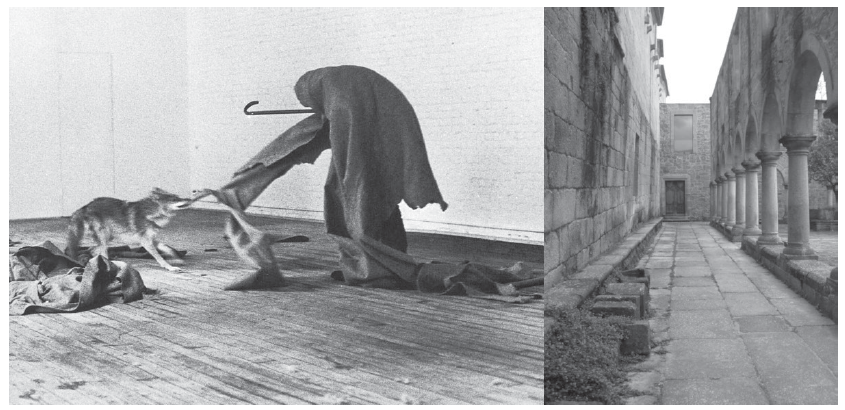
Fig. 1 The Coyote versus the ruin Joseph Beuys’ performance “I like America and America likes me” (1974) and Eduardo Souto de Moura’s Pousada de Santa Maria do Bouro by Gisela Schmoll (1997). Source:https://www.kidsofdada.com/blogs/magazine;https://www.flickr.com/photos/gschmoll.
5. The other as a lesson.
This kind of understanding wasn’t a new stance when intervening in heritage architecture: since 1964 the Venice Charter (a document written about good practices in historical buildings’ intervention) recommended that any intervention made in architectural heritage should clearly state the moment when such intervention was made, instead of copying the past, falsifying its history (Gazzola & Lemaire, 1964). There is a clear perception that a historical building is the result of several moments, each one designed according to its tradition. Therefore, there isn’t a unique style, and “us”, while intervening in the present moment, should design according to our own moment’s style, spatial and constructive solutions, while searching for “an architectural conciliation or harmony” (Gazzola & Lemaire, 1964).
Off course, the idea of conciliation or harmony (or understanding) depends on one’s interpretation, which is still reasonable, since in the past other architects also interpreted Romanic or Gothic styles, for example, according to their sensibility (although the result was less “obvious” than in contemporary interventions).
Today’s architectural diversity makes more pressing the need for the architect to devise an intervention theory, towards a base point from which he can become another “moment” in a building’s history. However, to interpret a building’s features which define its identity, as opposed to those that, if removed, don’t, is something where just “liking” or “not liking” is not enough.
Considering a humbler example than a monastery, let’s focus on a particular feature of a Portuguese popular house, as a case study: the stonework which framed doors and windows, sometimes plain, others with sculptured motifs. How do we interpret these elements? Are they merely decorative? Are they part of the house’s identity? Adding them to a new building can contribute to its identity and the identity of, let’s say, a historic city centre?
If in the previous example, the architect used another artist’s work for us to “understand” its creative process, we will now “feed” ourselves in another artist’s work to “create” a design methodology: Joseph Kosuth played a major role in Conceptual Art’s definition, through is 1969 essay “Art after Philosophy” (Kosuth, 1991), from which resulted in his most well-known pieces: one of them is “One and Three Chairs”, important enough to endure in our memory and also to give birth to other’s artwork, that we, in due time, will refer.
For now, we will solely dwell on the understanding of this seminal piece of art from the viewpoint of our intentions, which is to devise an intervention methodology. We will start with a broader comprehension of it, namely the transposition it makes from linguistics’ definitions of Sign, Signifier and Signified, to art in general: in this case, the image we have of a chair - the Sign - which can be deconstructed in two levels of comprehension, where Signifier is the Sign’s “material and tangible element”, and the Signified is its “concept and abstract entity” (Flatschart, 2013). Or, to simply put it, the physical chair, and its definition.
Although it seems obvious enough not to be stated in a work of art (even more tautologically, as Kosuth did and advocated as one of the main features of Conceptual Art), this deconstruction will help us to define our (historical) references and how to use them. Let’s pick up on the above-mentioned example: can we identify that stonework as a historical feature? Can we use it as a historical reference?
We will try to decipher the “object” through (our interpretation of) Kosuth’s reasoning: the stonework consists of the Sign, which we can deconstruct in the Signifier: rigged stone into parallelepipedal elements, decorated or not, framing an opening; and the Signified: “structural elements designed to support the upper wall over window’s openings”.
So, it seems that “our” window frames can only keep their consistency once they “look” like stonework, but also if they maintain their structural purpose. To use them in a new building, constructed according to modern techniques where there are no load-bearing walls, it would be to subvert its definition (to support something) while keeping its image (a stone “frame”).
We can easily accept that establishing historical analogies solely through aesthetical elements is a stance like any other, especially in today’s architectonic diversity, but, probably, consistency is an item in which we can sustain a well-devised theory (about architectural heritage, conceptual art, or product design). Therefore, stonework can characterise architecture in a given place, through its colour and texture (besides any tectonic considerations), and therefore can be used “only” through its aesthetical value. But, in this case, it would only be consistent if it was designed in a way that could show that those elements have no structural purpose.
6. The other as a reference.
We have been sustaining our thinking in the fact that Kosuth expressed the need for coherence through a correlation between Sign, Signifier and Signified, voiced through pieces like One and Three Chairs (and others that, through image, object, and definition, stated the same correlation). However, we have yet to sustain that stance, since the artist itself (apparently) made no mention of this feature.
We already acknowledged that Kosuth’s 1969 essay “Art after Philosophy” was seminal to establish the principles upon which Conceptual Art would be defined. Aesthetics was not one of those principles, since its appraisal has always been a matter of taste or opinion, and at the time (conceptual) art seek to take philosophy’s place, as it was before: grounded upon science and rationality, which was abandoned in the 19th century when philosophy became uncommitted enough to admit the existence of religion.
As a result, evaluating art according to how it looks made as much sense as evaluating architecture with the same principles (Kosuth, 1991, p. 16), ignoring all the spatial and practical solutions that allow a building to fulfil its purpose. It must be said that such reasoning must have been deeply grounded in early 20th-century architecture (specifically Functionalism) whose faith in science, by that time, had already started to fade (Montaner, 2001). However, the fact that Kosuth resorted to its example in his manifesto justifies the use of architectural examples in our present paper.
So, the redefinition of art according to a scientific posture, while revoking all traditional art expressions, led to an analytical proposal based on (the artist’s) experience. Such a deeply personal experience could only be understood by him; thus, he is the only one who can truly advocate if his work is art or not, revoking the observer’s part in the process: the devised concept or logic, which led to the physical artwork, is art’s true expression, repeated tirelessly - tautologically - resorting to a visual expression.
We can point two things to this logic: the first is the fact that, while denying a personal interpretation by the viewer (be it aesthetical, formal, or functional) in favour of a scientific-like approach, Kosuth substitutes that interpretation with the artist’s view, which is also deeply personal (and not an undeniable truth). This might oppose other conceptual artworks, in which such truth is presented as a choice that can be made by the author or by the viewer: John Hillards’ piece “Camera recording its own condition (7 Apertures, 10 Speeds, 2 Mirrors)” presents 70 pictures taken using different combinations of aperture and shutter speed. None of them is presented as the “right one”, although the fact that they are displayed on a grid 10x7 leads our eyes to the two at the centre. If Hillard had composed its piece with an odd number of lines there would be a single centre photo, and therefore a “chosen” one. An even number of columns would double his/our “options”.
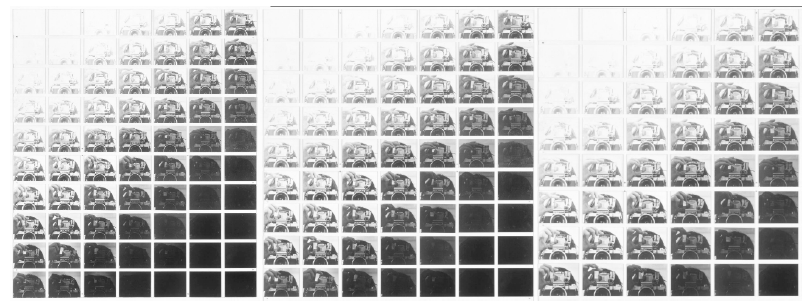
Fig. 3 Two, one and four options. Reducing or adding choices to Hillard’s “Camera recording its own condition (7 Apertures, 10 Speeds, 2 Mirrors)” Source: collage made from pictures of John Hillard’s artwork, by the author.
Second, the concept, personal and private as it is, is also the only means to define art, and relies solely on the artist’s mind. So, the only appreciation we, as observers, can make, is sensory, and the unfathomable truth is never within our reach - and nothing guarantees us that it has ever existed.
So, we can state that Kosuth wasn’t able to devoid art of sensory meaning, despite his efforts (something Hillard never tried to do). It also appears that he could have headed art, in general, into a situation where the search for meaning also led to the possibility that art can be completely devoid of it. However, through the interpretation made in the previous chapter, we can think that Kosuth was, in fact, conscious of this peril, and his work, like “One and Three Chairs” (or Plants, or Hammers, or Rakes) consisted in the reiteration of the need for Conceptual Art to propose not only a Concept but also an Artistic Expression that should be true to that Concept. In other words, for the Sign (art) to be the result of a logical coherence between Signifier (the art’s expression) and Signified (the concept).
If we accept this, we also have to think about the following: that the above-mentioned artwork from this period was not an example of Conceptual Art, but the physical manifestation of “Art after Philosophy” - an extension of the manifesto - in which Kosuth tautologically exposed the imperative need for the Sign/Signified/Signifier correlation, attained not also through the artist’s intellect but also his ethical values, in which the observer dwells to “trust” his work. Also, among Kosuth’s intended observers, were not only the general public, art connoisseurs, or art critics, but also, if not especially, artists themselves.
7. In conclusion
This is why “One and Three Chairs’” appropriation by other artists makes so much sense when they debate questions of interpretation or comprehension: “Cher, Chair, Share”, by Ole Ukena (2011) uses an intended act of misinterpretation to highlight the power of language to separate or bring us together, a resource also used by Aim Deuelle Luski in “Joseph Kosuth Tribute: One and Three Chairs” (2012), and Mansoor Ali in “Three Chairs and N/None (after Joseph Kosuth)” (2016). In Carlos Monroy’s performance “Mr Kosuth, what would you do?” (2012) the artist invited his audience to create their connections using Concepts, Objects and Meanings made available by him (in which he included himself), while Antonio Guiotto expanded Kosuth’s tautology within the same exposed Sign, Signified and Signifier - just to name a few.
This leads us to conclude that, for Joseph Kosuth, even if Conceptual Art’s meaning resides solely in the author’s head, there is still the need for the observer to know that such meaning exists, and that art is not an act of fortuity.
If not, and since the communication of such meaning is not mandatory, “believing” in its existence would be an act of faith, which it could not be, since art, as he intended, was to substitute philosophy - which started to fail as a science the moment it accepted the existence of religion. So, how do we “believe” in such meaning? How do we make it more than a matter of trust?
As it was pointed out above, strong ethical values were fundamental for those who made Conceptual Art, like Kosuth kept “saying” through his artwork which tautologically stated the need for harmony among Sign, Signifier and Significant.
Tautology, however, was also a way to state that a recurring image corresponds to a recurring meaning. Or, to put it in other words, Coherence or Consistency within an artist’s artwork is the proof that there is a Meaning underlying its practice.
We are not stating that Souto de Moura needed Kosuth’s work to define his principles in architecture. We can also appreciate his (art)work solely through its Minimalistic aesthetics, which, however, would be impossible without an underlying concept: the coherence Souto de Moura’s architecture has achieved through the years proves that there is, in fact, a solid concept underneath it - even if it’s not often verbally revealed.
We can also see through Souto de Moura’s presentation that Contemporary Art can encourage thinking and practice in Architecture, but especially that Knowledge, in general, can help us create the necessary consistency to create great art, architecture, design, etc. As such, Culture doesn’t need to have a purpose in mind to be acquired, all encounters being case studies that will find their use even in unexpected circumstances: “culture (…) in addition to providing knowledge and entertainment, has a consoling capacity as it invites us to exercise acceptance” (Aramburu, 2022).
The author’s personal experience - while evaluating Popular architecture through a small part of what establishes its identity, across a linguistic analysis - is nothing more than a reiteration of the idea that “intersecting” knowledge is a fundamental tool.
Eventually, it led to the deconstruction of Kosuth’s Conceptual Art theory, which allowed us back to Souto de Moura and create another level of understanding of his architecture, thus “closing the triangle”.
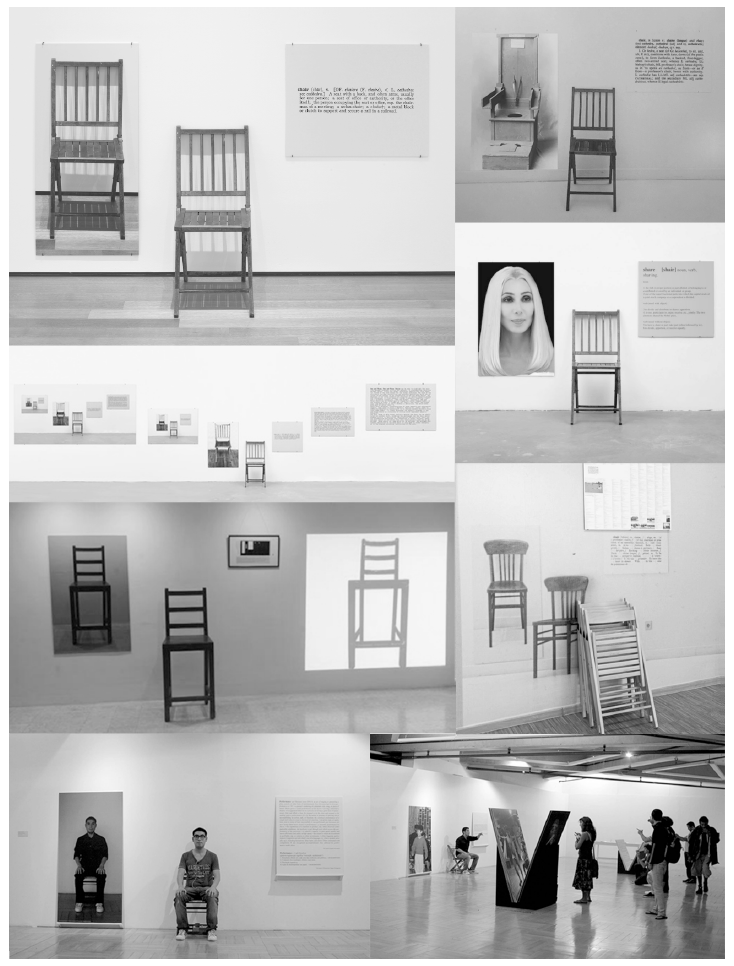
Fig. 5 One and Three Chairs as a physical theory. From top to bottom, left to right: “One and Three Chairs”, Joseph Kosuth, 1965; “Joseph Kosuth Tribute: One and Three Chairs”, Aim Deuelle Luski, 2012; “Cher Chair Share”, Ole Ukena, 2011; “One and Three, One and Three, One and Three Chairs”, Antonio Guiotto, 2012; “Three Chairs and N/one (After Joseph Kosuth)”, Mansoor Ali Makrani, 2015-16; “One and Three Chairs (Winterthur)”, Michael Riedel, (nd); “Monroy's performance service no.1 Mr Kosuth, what would you do?”, Carlos Monroy, 2012. Source: collage from pictures of the artwork of the above-mentioned artists, by the author.














